Art & Exhibitions
artnet Asks: Science Geek and Epic Sculptor Conrad Shawcross
It's all about science, maths, and self-imposed rules for this young artist.
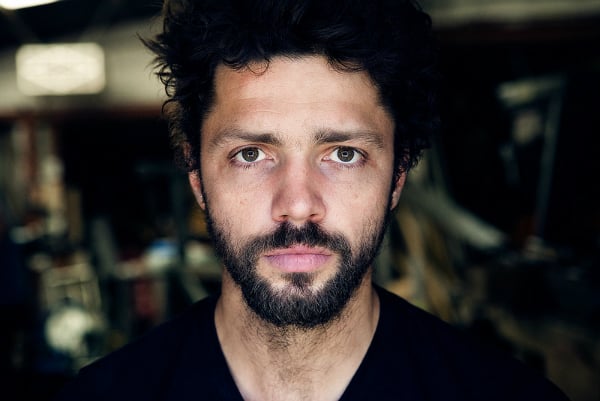
Photo via: Home of the Noblemen
It's all about science, maths, and self-imposed rules for this young artist.

Amah-Rose Abrams

It’s going to be a busy summer for British sculptor Conrad Shawcross. Between now and October, he will have three public sculptures in London: one in the Royal Academy courtyard, another one in Dulwich Park– these are already installed- and the largest of them all, on the busy pavement outside the newly renovated Kings Cross station (see Conrad Shawcross Tapped for King’s Cross Art Installation).
He also has three shows currently running in London and Southern England: “Manifold” at New Art Center, Salisbury; “Counterpoint” at Dulwich Picture Gallery, London; and “Inverted Spires and Descendant Folds,” which opens today at Victoria Miro Gallery.
Shawcross is best known for his work with science and geometry, realized in metal and glass. The works on view in his current exhibitions range from sculpture based on strict algorithms and robotics to the shape of a musical chord falling into silence.
Shawcross is also currently working on an installation for the Museum of Old and New Art in Tasmania, Australia, which, when realized, will see a 9 meter-tall rope machine permanently on view in the foyer of the museum.
We spent some time with Shawcross as he was installing his show at Victoria Miro Gallery and asked him about his busy summer, interlinking projects, and inspiration.
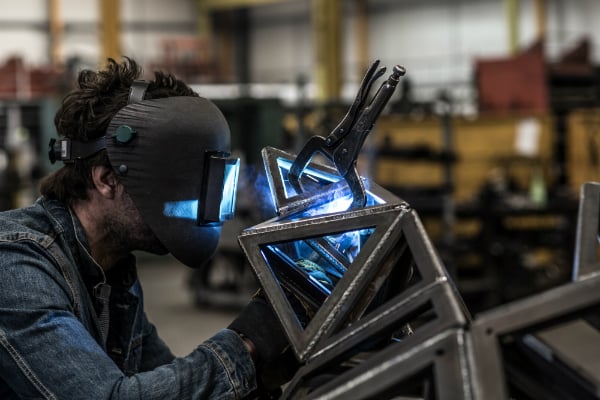
Conrad Shawcross at work
Photo: courtesy Victoria Miro
You have a lot of projects on at the moment, how did that come about?
It’s wasn’t intentional, but it’s become this sort of season. I think as a sculptor you take on projects and often a lot of things don’t happen or get delayed, and sometimes things pan out, but this year has been a perfect storm of everything happening at once.
Dulwich Park was supposed to open six, seven, or eight months ago, but it got delayed and then we decided to do it in spring. The Dulwich Picture Gallery show was off the back of that, and then the Royal Academy installation was discussed before Christmas and it was kind of “this year or never.” So we had to take it on.
This (Victoria Miro) show came quite late in the day, because I had all this supporting work inspired by this project in King’s Cross, and these are all studies that have come out of it.
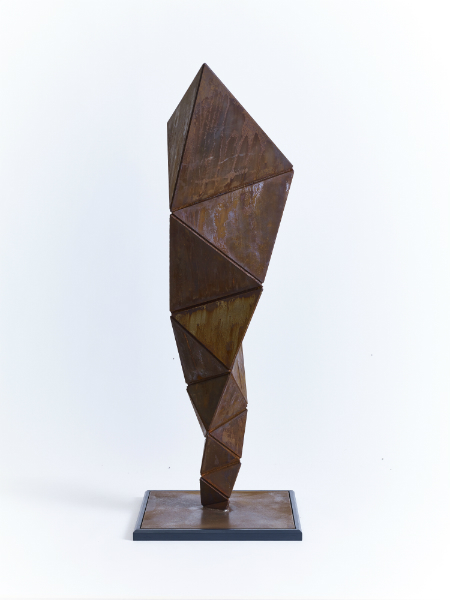
Conrad Shawcross, Paradigm (study for the King’s Cross installation, 2014)
Photo: Courtesy Victoria Miro
Do you think it is part of being a successful artist, having to create so much work?
No (laughs)! I don’t think I should have to do this every month. I think it’s a great moment but it’s not the way I want to work all the time.
A lot of your ideas stem from science or mathematics. Where does an idea start for you: with the science or with the shape?
It’s starts as an idea, and the shape comes out of it. There are certain rules or logic that I apply but there’s also a philosophy with everything. These pieces in essence take on a single rule, where there are essentially stacks but they are tetrahedral stacks.
Applying rules makes it easier in a way. As an artist, I don’t like the blank. I like to give myself these constraints, which actually make it easier to be creative.
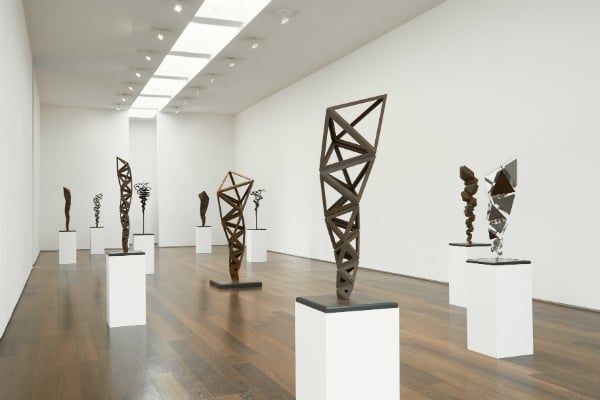
Conrad Shawcross, installation view of “Inverted Spires and Descendent Folds”
Photo: Courtesy Victoria Miro
Tell me about your show you at Victoria Miro.
There are a lot of these stack pieces, and a lot of these stack pieces are about the idea of growth. So you keep building this tower, and it gets bigger and mightier as you go up, but it also becomes more fallible.
I call them “paradigms” because of the idea of the paradigm shift or collapse. That’s where you keep growing your argument, even though it becomes bolder and stronger, it also becomes more sensitive and more vulnerable.
That’s not necessarily a bad thing, it’s part of healthy science. Old ideas have to be toppled by new ones and it’s not a bad thing, it’s progress.
Speaking of the precarious, is it in inspired by the global political situation? The Middle East, climate change, the global financial situation?
Yes definitely, there’s one work, Axiom (2007), which is a 14 meter high regular tetrahedron, so it keeps the same thickness as it goes up. It was very much about the idea of growth, and that we were sort of teetering at the time on the edge of this abyss, which was the crisis.
Aside from politics and science, where do you draw inspiration from? Are you inspired by other contemporary artists?
Yes, I am. The things I get more inspired by are not necessarily people of my own medium, because if you’re immersed in a medium it’s very difficult to find things in it. You see it structurally, how it’s done, and the way it’s assembled, and it’s a not very romantic way of looking at things.
When I go to a painting show and I see something I don’t necessarily understand, or how it’s made, it’s much more easy to enjoy it. I really liked the Sarah Lucas exhibition at the British Pavilion in Venice this year (see Sarah Lucas Shocks and Delights in Venice with Genitalia-Filled Pavilion).
Your work is very “modern” in the true meaning of the word. Do you draw inspiration from artists throughout history?
I do, of course. There are a lot of rule-based artists that I enjoy, like Sol LeWitt and artists who use these sorts of mechanisms. He would use a cube to create these rule-based drawings, and I’m very much into that minimalist way of working. And obviously, the big sculptors of our time, like Richard Serra (see Richard Serra Receives French Legion of Honor Award).
Constantin Brancusi’s tower (Column of the Infinite, 1938) is something I have been looking at as well. I’m very interested in creating these monumental public pieces that will be really enjoyed in a civic setting.
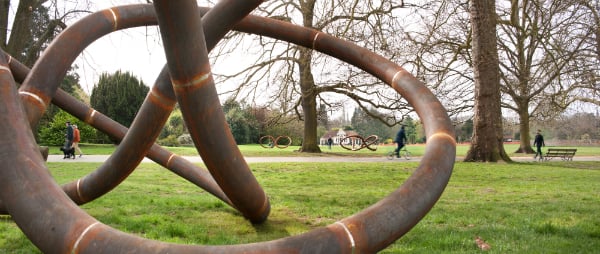
Conrad Shawcross, Three Perpetual Chords (2015) at Dulwich Park
Photo: Courtesy Victoria Miro
Do you feel differently about work made for public and private contexts?
Yeah, it’s a different approach. This piece I am working on now, which is going to be in the middle of the pavement, has got to be un-climbable, it has to be a totemic, civic object. Whereas the piece in the park is the complete opposite. It’s about the approach, it’s about tactility, it’s about play, and it has to resonate with the trees, nature, and grass, as well as with the natural, low environment. The materials, the palette, and the form of my works are completely driven by the context.